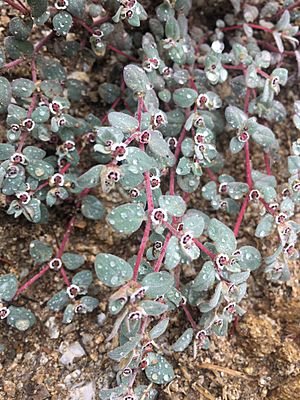Red-gland spurge facts for kids
Quick facts for kids Red-gland spurge |
|
|---|---|
 |
|
| Scientific classification | |
| Genus: |
Euphorbia
|
| Species: |
melanadenia
|
| Synonyms | |
|
Chamaesyce melanadenia |
|
Euphorbia melanadenia is a fascinating plant known by the common name red-gland spurge. It's a type of plant that grows back year after year, forming small clumps or mats. You can find it in the dry, rocky areas of deserts and mountains. This plant is native to places like Baja California in Mexico, and southern parts of California and Arizona in the United States.
Contents
Where the Red-Gland Spurge Lives
This plant loves dry, rocky places. It grows naturally in the deserts and mountains of Baja California, which is a peninsula in Mexico. You can also spot it in the southern parts of California and Arizona. It's well-suited to these tough, dry environments.
What the Red-Gland Spurge Looks Like
The red-gland spurge forms a small group of plants or a flat mat close to the ground. It has very thin, reddish stems that can tangle together. Along these stems, you'll find pairs of small, oval-shaped leaves. These leaves are usually between 2 and 9 millimeters wide and might feel a little bit woolly.
Its Unique Flowers
The flowers of the red-gland spurge are quite tiny. They are part of a special flower structure called a cyathium. This cyathium is less than 2 millimeters wide. It looks like a small, bell-shaped cup with white, scalloped parts that resemble petals.
At the bottom of each of these petal-like parts, there's a shiny red spot. These spots are actually nectar glands, which produce a sweet liquid to attract insects. Inside the cyathium, you'll find the real flowers. There's a ring of male flowers (called staminate flowers) surrounding a single female flower in the center.
How it Reproduces
After the female flower is pollinated, it develops into a small, oval-shaped fruit. Inside this fruit, you'll find wrinkled white seeds. These seeds are how the red-gland spurge makes new plants and spreads in its dry habitat.

